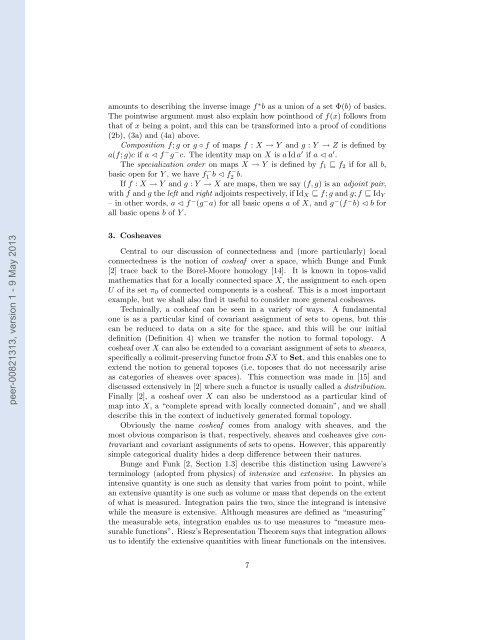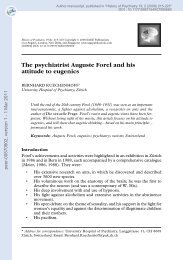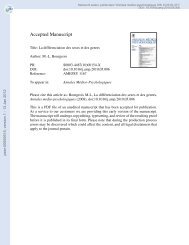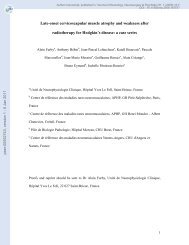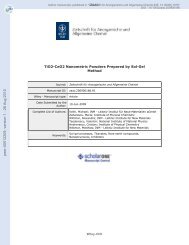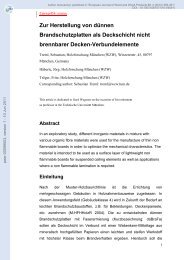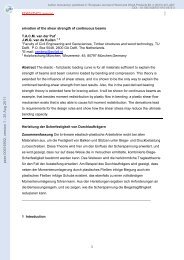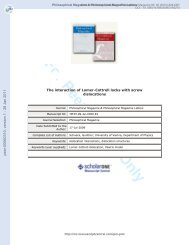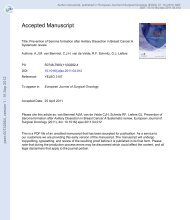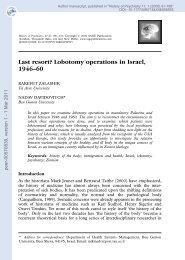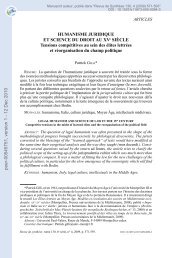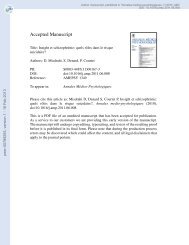Cosheaves and connectedness in formal topology
Cosheaves and connectedness in formal topology
Cosheaves and connectedness in formal topology
You also want an ePaper? Increase the reach of your titles
YUMPU automatically turns print PDFs into web optimized ePapers that Google loves.
amounts to describ<strong>in</strong>g the <strong>in</strong>verse image f ∗ b as a union of a set Φ(b) of basics.<br />
The po<strong>in</strong>twise argument must also expla<strong>in</strong> how po<strong>in</strong>thood of f(x) follows from<br />
that of x be<strong>in</strong>g a po<strong>in</strong>t, <strong>and</strong> this can be transformed <strong>in</strong>to a proof of conditions<br />
(2b), (3a) <strong>and</strong> (4a) above.<br />
Composition f; g or g ◦ f of maps f : X → Y <strong>and</strong> g : Y → Z is def<strong>in</strong>ed by<br />
a(f; g)c if a ⊳ f − g − c. The identity map on X is a Id a ′ if a ⊳ a ′ .<br />
The specialization order on maps X → Y is def<strong>in</strong>ed by f 1 ⊑ f 2 if for all b,<br />
basic open for Y , we have f − 1 b ⊳ f − 2 b.<br />
If f : X → Y <strong>and</strong> g : Y → X are maps, then we say (f, g) is an adjo<strong>in</strong>t pair,<br />
with f <strong>and</strong> g the left <strong>and</strong> right adjo<strong>in</strong>ts respectively, if Id X ⊑ f; g <strong>and</strong> g; f ⊑ Id Y<br />
– <strong>in</strong> other words, a ⊳ f − (g − a) for all basic opens a of X, <strong>and</strong> g − (f − b) ⊳ b for<br />
all basic opens b of Y .<br />
peer-00821313, version 1 - 9 May 2013<br />
3. <strong>Cosheaves</strong><br />
Central to our discussion of <strong>connectedness</strong> <strong>and</strong> (more particularly) local<br />
<strong>connectedness</strong> is the notion of cosheaf over a space, which Bunge <strong>and</strong> Funk<br />
[2] trace back to the Borel-Moore homology [14]. It is known <strong>in</strong> topos-valid<br />
mathematics that for a locally connected space X, the assignment to each open<br />
U of its set π 0 of connected components is a cosheaf. This is a most important<br />
example, but we shall also f<strong>in</strong>d it useful to consider more general cosheaves.<br />
Technically, a cosheaf can be seen <strong>in</strong> a variety of ways. A fundamental<br />
one is as a particular k<strong>in</strong>d of covariant assignment of sets to opens, but this<br />
can be reduced to data on a site for the space, <strong>and</strong> this will be our <strong>in</strong>itial<br />
def<strong>in</strong>ition (Def<strong>in</strong>ition 4) when we transfer the notion to <strong>formal</strong> <strong>topology</strong>. A<br />
cosheaf over X can also be extended to a covariant assignment of sets to sheaves,<br />
specifically a colimit-preserv<strong>in</strong>g functor from SX to Set, <strong>and</strong> this enables one to<br />
extend the notion to general toposes (i.e. toposes that do not necessarily arise<br />
as categories of sheaves over spaces). This connection was made <strong>in</strong> [15] <strong>and</strong><br />
discussed extensively <strong>in</strong> [2] where such a functor is usually called a distribution.<br />
F<strong>in</strong>ally [2], a cosheaf over X can also be understood as a particular k<strong>in</strong>d of<br />
map <strong>in</strong>to X, a “complete spread with locally connected doma<strong>in</strong>”, <strong>and</strong> we shall<br />
describe this <strong>in</strong> the context of <strong>in</strong>ductively generated <strong>formal</strong> <strong>topology</strong>.<br />
Obviously the name cosheaf comes from analogy with sheaves, <strong>and</strong> the<br />
most obvious comparison is that, respectively, sheaves <strong>and</strong> cosheaves give contravariant<br />
<strong>and</strong> covariant assignments of sets to opens. However, this apparently<br />
simple categorical duality hides a deep difference between their natures.<br />
Bunge <strong>and</strong> Funk [2, Section 1.3] describe this dist<strong>in</strong>ction us<strong>in</strong>g Lawvere’s<br />
term<strong>in</strong>ology (adopted from physics) of <strong>in</strong>tensive <strong>and</strong> extensive. In physics an<br />
<strong>in</strong>tensive quantity is one such as density that varies from po<strong>in</strong>t to po<strong>in</strong>t, while<br />
an extensive quantity is one such as volume or mass that depends on the extent<br />
of what is measured. Integration pairs the two, s<strong>in</strong>ce the <strong>in</strong>tegr<strong>and</strong> is <strong>in</strong>tensive<br />
while the measure is extensive. Although measures are def<strong>in</strong>ed as “measur<strong>in</strong>g”<br />
the measurable sets, <strong>in</strong>tegration enables us to use measures to “measure measurable<br />
functions”. Riesz’s Representation Theorem says that <strong>in</strong>tegration allows<br />
us to identify the extensive quantities with l<strong>in</strong>ear functionals on the <strong>in</strong>tensives.<br />
7


